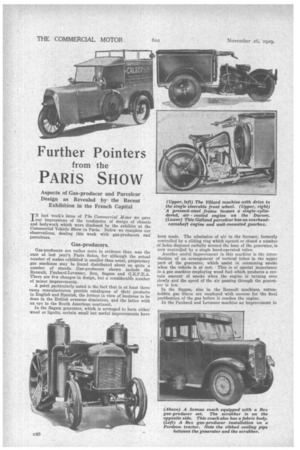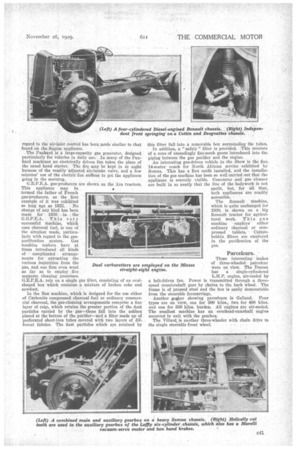Further Pointers from the
Page 78

Page 79

If you've noticed an error in this article please click here to report it so we can fix it.
PARIS SHOW
Aspects of Gas-producer and Parcelcar Design as Revealed by the Recent Exhibition in the French Capital TN last week's issue of The Commercial Motor we gave _Lour impressions of the tendencies of design of chassis and bodywork which were disclosed by the exhibits at the Commercial Vehicle Show in Paris. Below we complete our observations, dealing this week with gas-producers and pareekars.
Gas-producers.
Gas-producers are rather more in evidence than was the _ case at last year's Paris Salon for although the actual number of makes exhibited is smaller than usual, proprietary gas machines may be found distributed about on quite a number of stands. Gas-producers shown include the Renault, Panhard-Levassor, Rex, Sagam and G.E,P.E.A. There are few changes in design, but a considerable number of minor improvements.
A point particularly noted is the fact that in at least three cases manufacturers provide catalogues of their products in English and Spanish, the former in view of business to be done in the British overseas dominions, and the latter with an eye to the South American continent.
In the Sagam generator, which is arranged to burn either wood or lignite, certain small but useful improvements have been made. The admission of air to the furnace, formerly controlled by a sliding ring which opened or closed a number of holes disposed radially around the base of the generator, is now controlled by a single hand-operated valve. Another useful improvement in this machine is the introduction of an arrangement of vertical tubes in the upper part of the generator, which assist in consuming smoke when the vehicle is at rest. This is of special importance in a gas machine employing wood fuel which produces a certain amount of smoke when the engine is turning over slowly and the speed of the air passing through the generator is low.
In the Sagam, also in the Renault machines, cottonbobbin gas filters are employed with success for the final purification of the gas before it reaches the engine. In the Panhard and Levassor machine an improvement in regard to the air-inlet control has been made similar to that found on the Sagam appliance.
The Panhard is a large-capacity gas generator, designed particularly for vehicles in daily use. In many of the Panhard machines an electrically driven fan takes the place of the usual hand starter. The Ere may be kept in at night because of the readily adjusted air-intake valve, and a few minutes' use of the electric fan suffices to get the appliance going in the morning.
G.E.P.E.A. gas-producers are shown on the Ara tractors. This appliance may be termed the father of French gas-producers, as the• first example of it was exhibited so long ago as 1922. No change of any kind has been made for 1930 . in the G.E.P.E.A. This very successful machine, which uses charcoal fuel, is one of the simplest made, particularly with regard to the gaspurification system. Gas machine makers have at times introduced all kinds of complicated arrangements for extracting the various impurities from the gas, and one firm even went so far as to employ five separate cleaning processes. G.E.P.E.A. rely on a single gas filter, consisting of an ovalshaped box which contains a mixture of broken coke and sawdust.
In the Rex machine, which is designed for the use either of .Carbonite compressed charcoal fuel or ordinary commercial charcoal, the gas-cleaning arrangements comprise a fine layer of coke, which retains the greater portion of the dust particles carried by the gas—these fall into the ashbox placed at the bottom of the purifier—and a filter made up of perforated sheet-iron tubes covered with two• layers of different fabrics. The dust particles which aye retained by this filter fall into a removable box surrounding the tubes. In addition, a " safety " filter is provided. -This consists of a cone of exceedingly fine-mesh gauze introduced into the piping between the gas purifier and the engine. An interesting gas-driven vehicle in the Show is the fine 14-seater coach for North African service exhibited by Somua. This has a Rex outfit installed, and the installation of the gas machine has been so well carried out that the appliance is scarcely visible. Generator -and gas cleaner are built in so neatly that the line of the bodywork is not spoilt, but, for all that, both appliances are readily accessible.
The Renault machine, which is quite unchanged for 1930, is shown on a big Renault tractor for agricultural work. This gas machine .• employs either ordinary charcoal or compressed tablets.Cottonbobbin, filters are employed in the purification of the gas.
Parcelcars.
Three interesting makes of three-wheeled parceicar were on view. The Ducom has a single-cylindered 1.1.74.P. engine, air-cooled by a belt-driven fan. Power is transmitted through a threespeed countershaft gear by chains to the back wheel. The frame is of pressed steel and the box is easily demountable from the steerable forecarriage.
Another Anaker showing parcelcars is Galland. Four types are on view, one for 300 kilos., two for 400 kilos. and one for 500 kilos. burden. All engines are air-cooled. The smallest machine has an overhead-camshaft engine mounted in unit with the gearbox.
The Villard is another three-wheeler with chain drive to the single stee'rable front wheel.




























































































































